Nursing Reflection: Patient Communication in Aged Care Nursing
VerifiedAdded on 2021/06/17
|6
|1269
|112
Journal and Reflective Writing
AI Summary
This nursing reflection explores the challenges faced by healthcare practitioners in aged care settings, using the case of Rosa to illustrate communication barriers and pain management issues. The reflection employs Gibb's reflective framework to analyze the difficulties encountered, particularly concerning Rosa's communication limitations and fear of pain, which hinder effective therapeutic interventions. It discusses the impact of these challenges on patient care, emphasizing the importance of adapting communication strategies and addressing psychological factors to improve patient outcomes. The paper highlights the need for practitioners to apply clinical and psychological strategies to ensure patient cooperation and consent in care processes, ultimately aiming for improved recovery and discharge. The author emphasizes the importance of persuasion, behavioral management techniques, and a collaborative approach involving psychologists and social workers to address patient concerns and enhance therapeutic effectiveness.
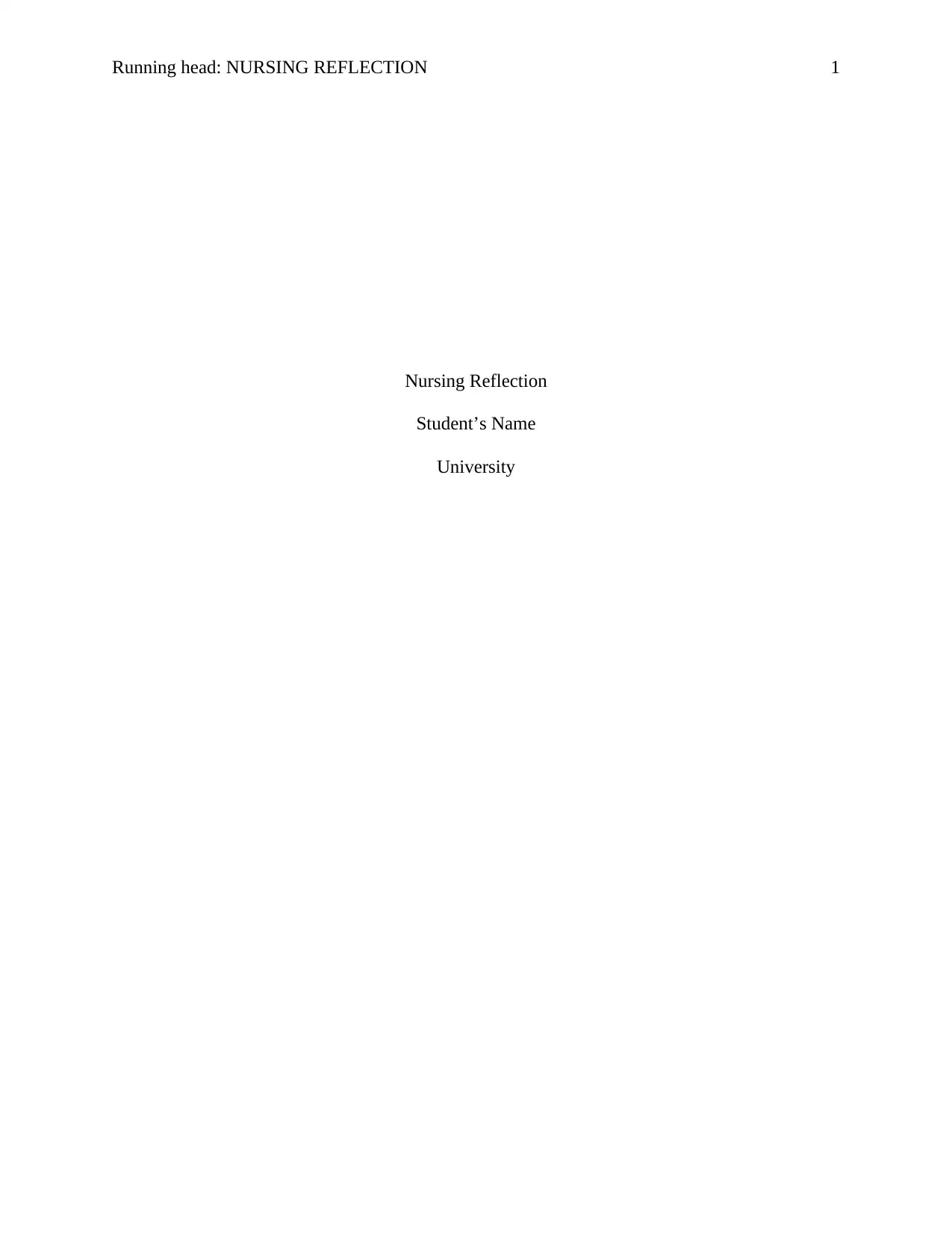
Running head: NURSING REFLECTION 1
Nursing Reflection
Student’s Name
University
Nursing Reflection
Student’s Name
University
Paraphrase This Document
Need a fresh take? Get an instant paraphrase of this document with our AI Paraphraser
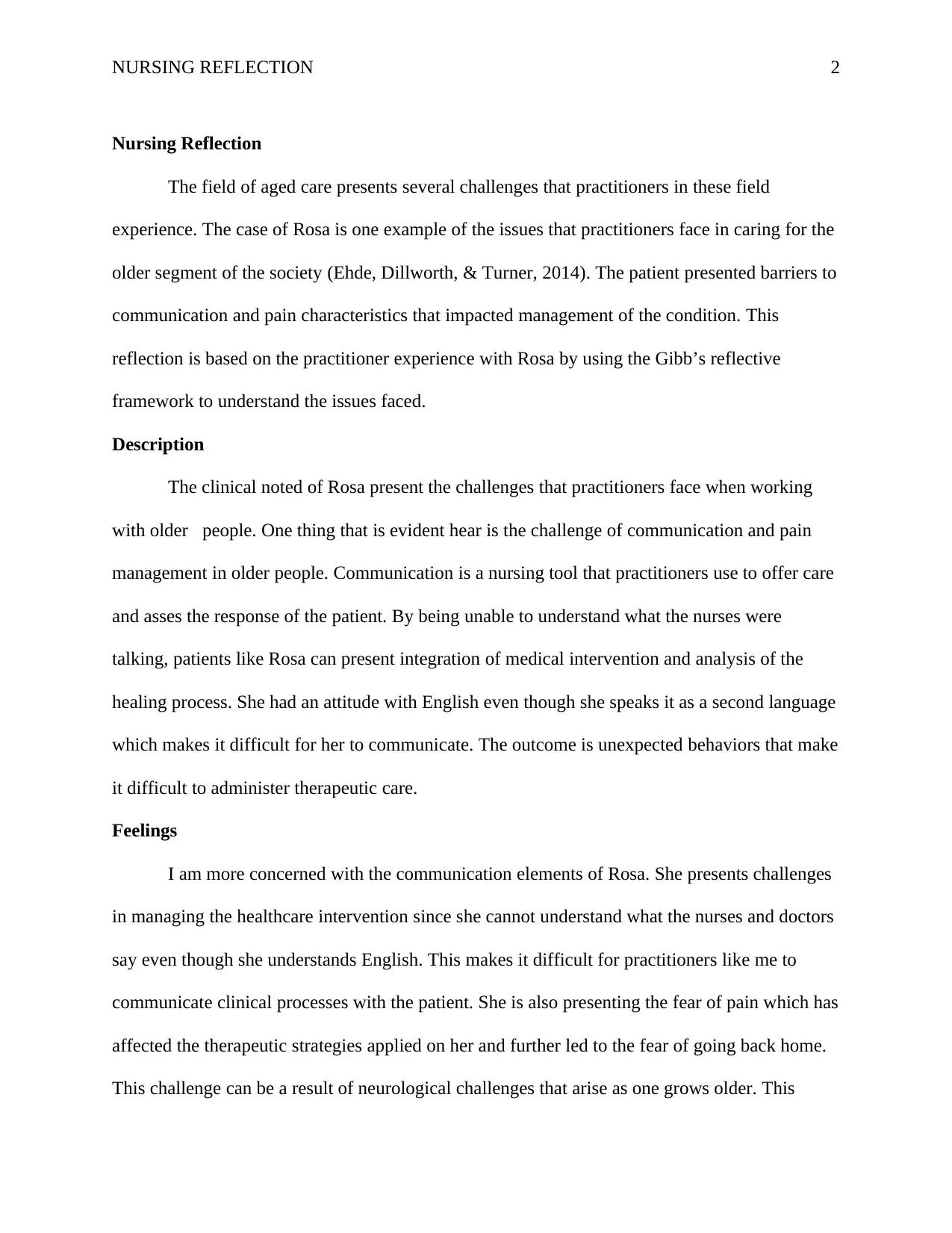
NURSING REFLECTION 2
Nursing Reflection
The field of aged care presents several challenges that practitioners in these field
experience. The case of Rosa is one example of the issues that practitioners face in caring for the
older segment of the society (Ehde, Dillworth, & Turner, 2014). The patient presented barriers to
communication and pain characteristics that impacted management of the condition. This
reflection is based on the practitioner experience with Rosa by using the Gibb’s reflective
framework to understand the issues faced.
Description
The clinical noted of Rosa present the challenges that practitioners face when working
with older people. One thing that is evident hear is the challenge of communication and pain
management in older people. Communication is a nursing tool that practitioners use to offer care
and asses the response of the patient. By being unable to understand what the nurses were
talking, patients like Rosa can present integration of medical intervention and analysis of the
healing process. She had an attitude with English even though she speaks it as a second language
which makes it difficult for her to communicate. The outcome is unexpected behaviors that make
it difficult to administer therapeutic care.
Feelings
I am more concerned with the communication elements of Rosa. She presents challenges
in managing the healthcare intervention since she cannot understand what the nurses and doctors
say even though she understands English. This makes it difficult for practitioners like me to
communicate clinical processes with the patient. She is also presenting the fear of pain which has
affected the therapeutic strategies applied on her and further led to the fear of going back home.
This challenge can be a result of neurological challenges that arise as one grows older. This
Nursing Reflection
The field of aged care presents several challenges that practitioners in these field
experience. The case of Rosa is one example of the issues that practitioners face in caring for the
older segment of the society (Ehde, Dillworth, & Turner, 2014). The patient presented barriers to
communication and pain characteristics that impacted management of the condition. This
reflection is based on the practitioner experience with Rosa by using the Gibb’s reflective
framework to understand the issues faced.
Description
The clinical noted of Rosa present the challenges that practitioners face when working
with older people. One thing that is evident hear is the challenge of communication and pain
management in older people. Communication is a nursing tool that practitioners use to offer care
and asses the response of the patient. By being unable to understand what the nurses were
talking, patients like Rosa can present integration of medical intervention and analysis of the
healing process. She had an attitude with English even though she speaks it as a second language
which makes it difficult for her to communicate. The outcome is unexpected behaviors that make
it difficult to administer therapeutic care.
Feelings
I am more concerned with the communication elements of Rosa. She presents challenges
in managing the healthcare intervention since she cannot understand what the nurses and doctors
say even though she understands English. This makes it difficult for practitioners like me to
communicate clinical processes with the patient. She is also presenting the fear of pain which has
affected the therapeutic strategies applied on her and further led to the fear of going back home.
This challenge can be a result of neurological challenges that arise as one grows older. This
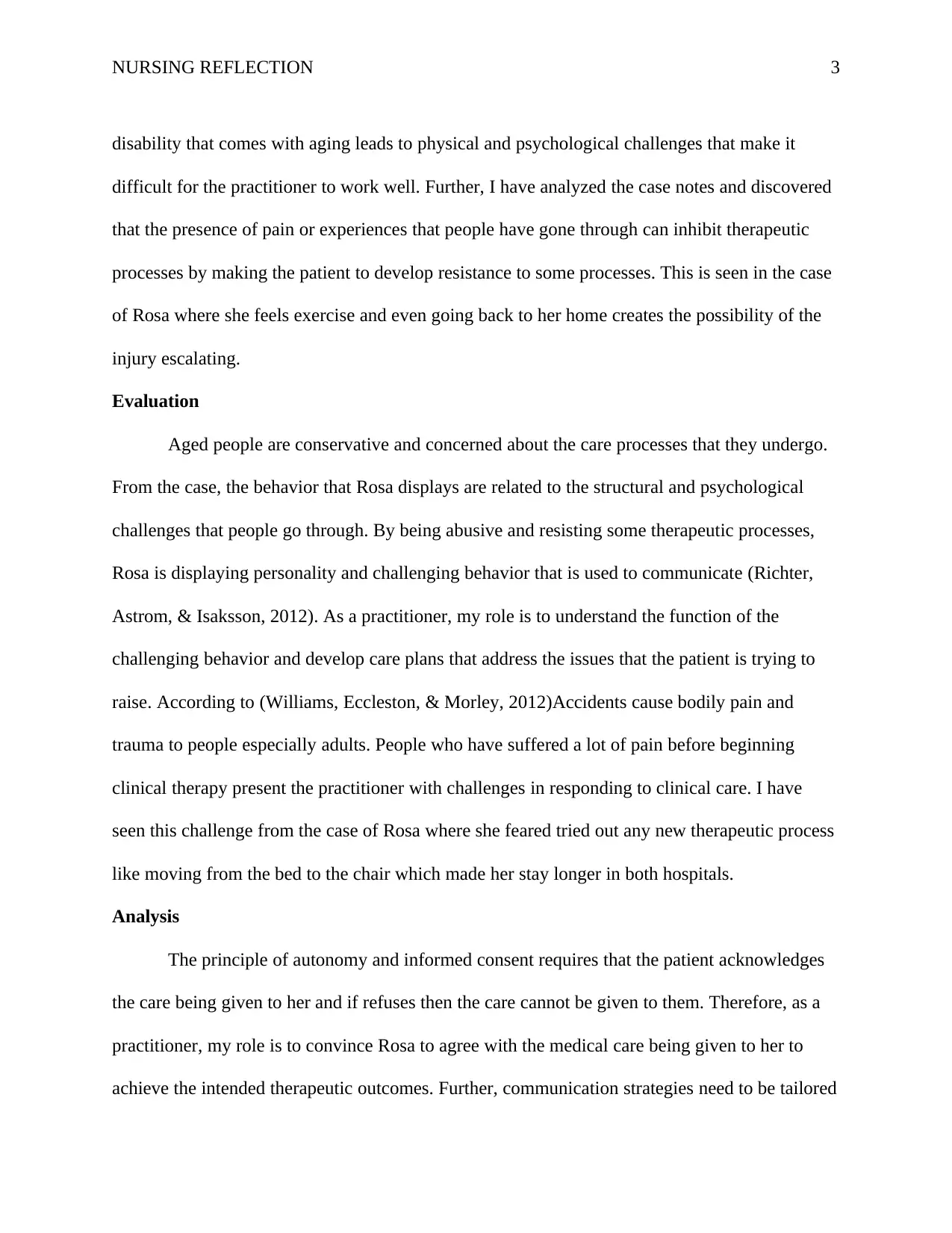
NURSING REFLECTION 3
disability that comes with aging leads to physical and psychological challenges that make it
difficult for the practitioner to work well. Further, I have analyzed the case notes and discovered
that the presence of pain or experiences that people have gone through can inhibit therapeutic
processes by making the patient to develop resistance to some processes. This is seen in the case
of Rosa where she feels exercise and even going back to her home creates the possibility of the
injury escalating.
Evaluation
Aged people are conservative and concerned about the care processes that they undergo.
From the case, the behavior that Rosa displays are related to the structural and psychological
challenges that people go through. By being abusive and resisting some therapeutic processes,
Rosa is displaying personality and challenging behavior that is used to communicate (Richter,
Astrom, & Isaksson, 2012). As a practitioner, my role is to understand the function of the
challenging behavior and develop care plans that address the issues that the patient is trying to
raise. According to (Williams, Eccleston, & Morley, 2012)Accidents cause bodily pain and
trauma to people especially adults. People who have suffered a lot of pain before beginning
clinical therapy present the practitioner with challenges in responding to clinical care. I have
seen this challenge from the case of Rosa where she feared tried out any new therapeutic process
like moving from the bed to the chair which made her stay longer in both hospitals.
Analysis
The principle of autonomy and informed consent requires that the patient acknowledges
the care being given to her and if refuses then the care cannot be given to them. Therefore, as a
practitioner, my role is to convince Rosa to agree with the medical care being given to her to
achieve the intended therapeutic outcomes. Further, communication strategies need to be tailored
disability that comes with aging leads to physical and psychological challenges that make it
difficult for the practitioner to work well. Further, I have analyzed the case notes and discovered
that the presence of pain or experiences that people have gone through can inhibit therapeutic
processes by making the patient to develop resistance to some processes. This is seen in the case
of Rosa where she feels exercise and even going back to her home creates the possibility of the
injury escalating.
Evaluation
Aged people are conservative and concerned about the care processes that they undergo.
From the case, the behavior that Rosa displays are related to the structural and psychological
challenges that people go through. By being abusive and resisting some therapeutic processes,
Rosa is displaying personality and challenging behavior that is used to communicate (Richter,
Astrom, & Isaksson, 2012). As a practitioner, my role is to understand the function of the
challenging behavior and develop care plans that address the issues that the patient is trying to
raise. According to (Williams, Eccleston, & Morley, 2012)Accidents cause bodily pain and
trauma to people especially adults. People who have suffered a lot of pain before beginning
clinical therapy present the practitioner with challenges in responding to clinical care. I have
seen this challenge from the case of Rosa where she feared tried out any new therapeutic process
like moving from the bed to the chair which made her stay longer in both hospitals.
Analysis
The principle of autonomy and informed consent requires that the patient acknowledges
the care being given to her and if refuses then the care cannot be given to them. Therefore, as a
practitioner, my role is to convince Rosa to agree with the medical care being given to her to
achieve the intended therapeutic outcomes. Further, communication strategies need to be tailored
⊘ This is a preview!⊘
Do you want full access?
Subscribe today to unlock all pages.

Trusted by 1+ million students worldwide
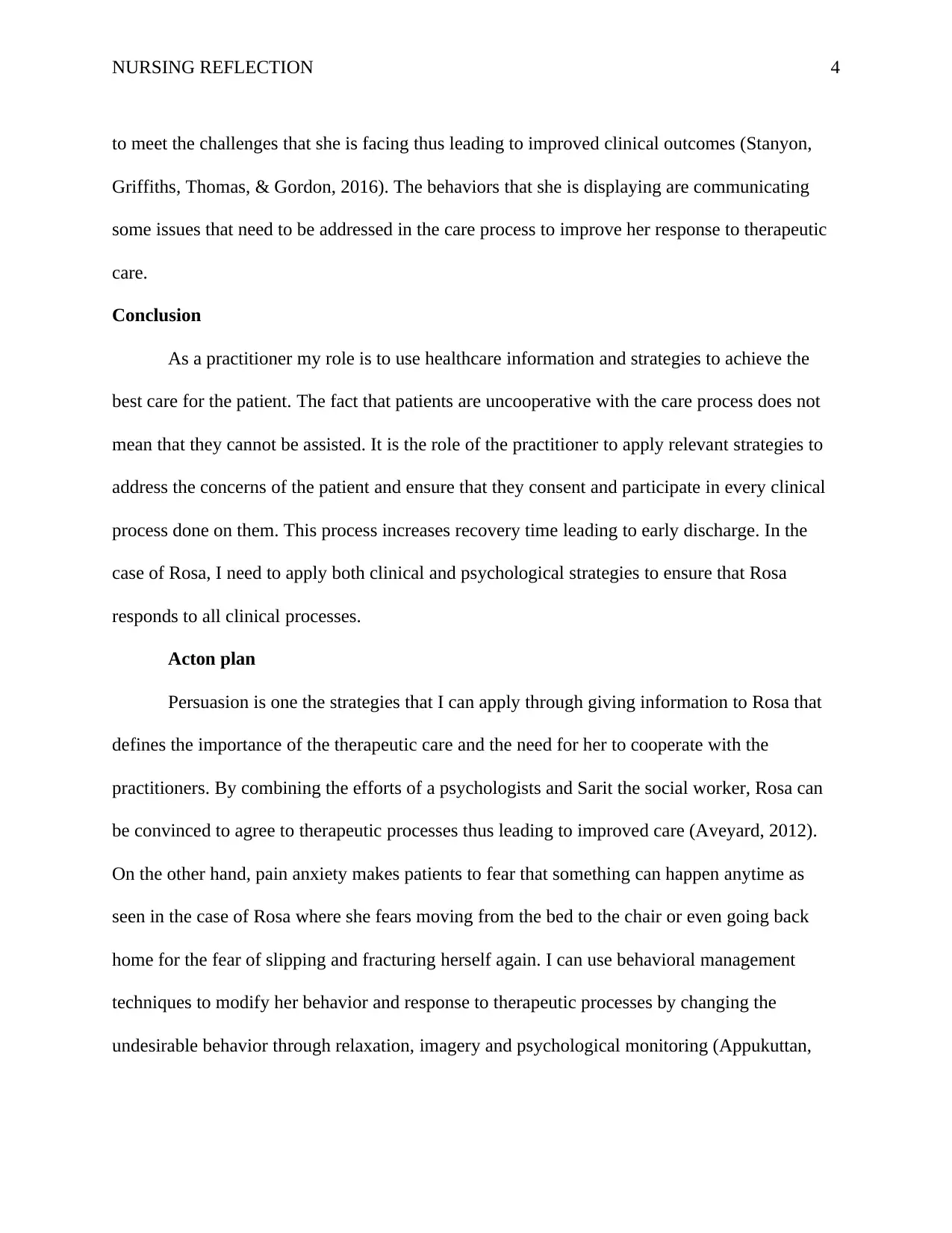
NURSING REFLECTION 4
to meet the challenges that she is facing thus leading to improved clinical outcomes (Stanyon,
Griffiths, Thomas, & Gordon, 2016). The behaviors that she is displaying are communicating
some issues that need to be addressed in the care process to improve her response to therapeutic
care.
Conclusion
As a practitioner my role is to use healthcare information and strategies to achieve the
best care for the patient. The fact that patients are uncooperative with the care process does not
mean that they cannot be assisted. It is the role of the practitioner to apply relevant strategies to
address the concerns of the patient and ensure that they consent and participate in every clinical
process done on them. This process increases recovery time leading to early discharge. In the
case of Rosa, I need to apply both clinical and psychological strategies to ensure that Rosa
responds to all clinical processes.
Acton plan
Persuasion is one the strategies that I can apply through giving information to Rosa that
defines the importance of the therapeutic care and the need for her to cooperate with the
practitioners. By combining the efforts of a psychologists and Sarit the social worker, Rosa can
be convinced to agree to therapeutic processes thus leading to improved care (Aveyard, 2012).
On the other hand, pain anxiety makes patients to fear that something can happen anytime as
seen in the case of Rosa where she fears moving from the bed to the chair or even going back
home for the fear of slipping and fracturing herself again. I can use behavioral management
techniques to modify her behavior and response to therapeutic processes by changing the
undesirable behavior through relaxation, imagery and psychological monitoring (Appukuttan,
to meet the challenges that she is facing thus leading to improved clinical outcomes (Stanyon,
Griffiths, Thomas, & Gordon, 2016). The behaviors that she is displaying are communicating
some issues that need to be addressed in the care process to improve her response to therapeutic
care.
Conclusion
As a practitioner my role is to use healthcare information and strategies to achieve the
best care for the patient. The fact that patients are uncooperative with the care process does not
mean that they cannot be assisted. It is the role of the practitioner to apply relevant strategies to
address the concerns of the patient and ensure that they consent and participate in every clinical
process done on them. This process increases recovery time leading to early discharge. In the
case of Rosa, I need to apply both clinical and psychological strategies to ensure that Rosa
responds to all clinical processes.
Acton plan
Persuasion is one the strategies that I can apply through giving information to Rosa that
defines the importance of the therapeutic care and the need for her to cooperate with the
practitioners. By combining the efforts of a psychologists and Sarit the social worker, Rosa can
be convinced to agree to therapeutic processes thus leading to improved care (Aveyard, 2012).
On the other hand, pain anxiety makes patients to fear that something can happen anytime as
seen in the case of Rosa where she fears moving from the bed to the chair or even going back
home for the fear of slipping and fracturing herself again. I can use behavioral management
techniques to modify her behavior and response to therapeutic processes by changing the
undesirable behavior through relaxation, imagery and psychological monitoring (Appukuttan,
Paraphrase This Document
Need a fresh take? Get an instant paraphrase of this document with our AI Paraphraser
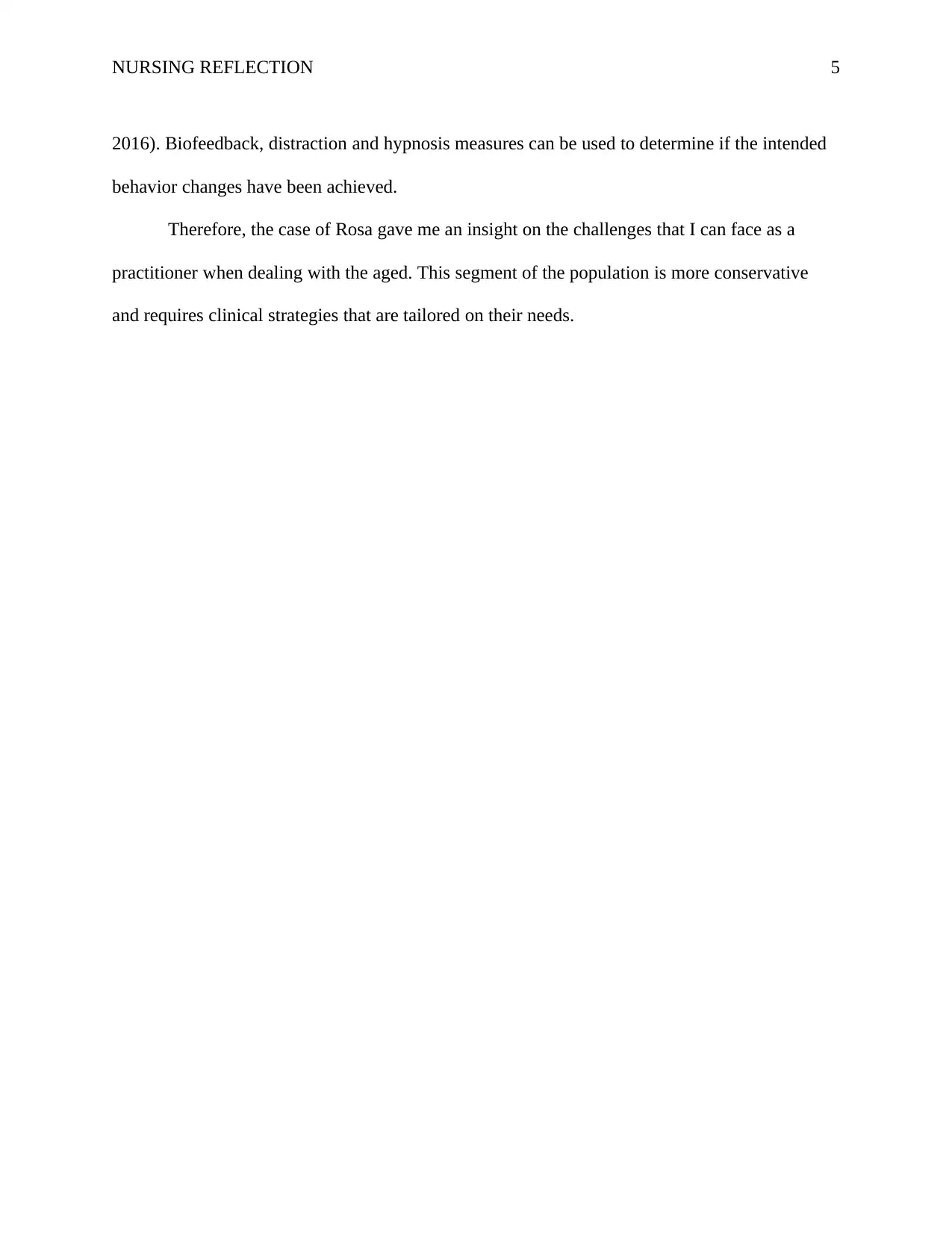
NURSING REFLECTION 5
2016). Biofeedback, distraction and hypnosis measures can be used to determine if the intended
behavior changes have been achieved.
Therefore, the case of Rosa gave me an insight on the challenges that I can face as a
practitioner when dealing with the aged. This segment of the population is more conservative
and requires clinical strategies that are tailored on their needs.
2016). Biofeedback, distraction and hypnosis measures can be used to determine if the intended
behavior changes have been achieved.
Therefore, the case of Rosa gave me an insight on the challenges that I can face as a
practitioner when dealing with the aged. This segment of the population is more conservative
and requires clinical strategies that are tailored on their needs.
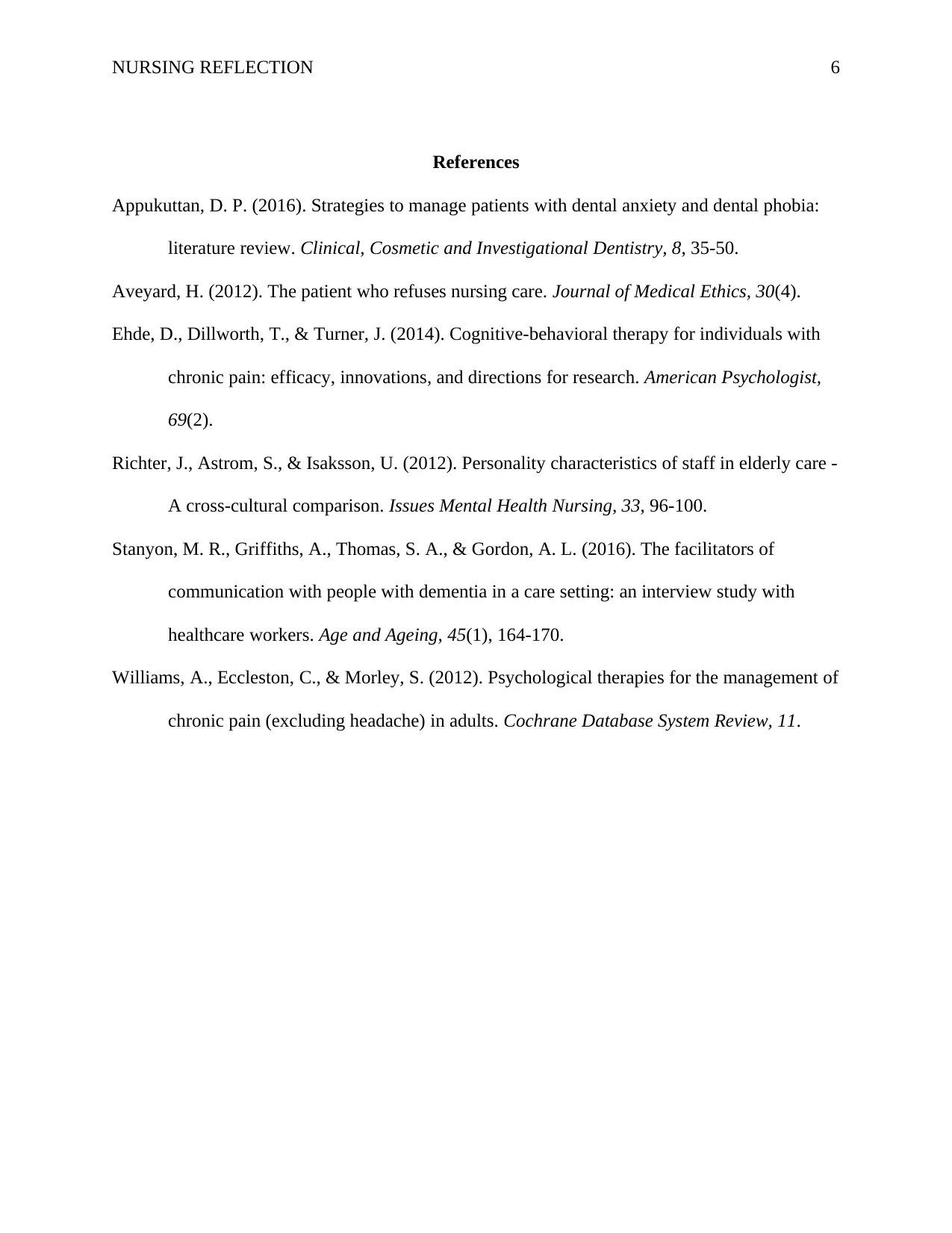
NURSING REFLECTION 6
References
Appukuttan, D. P. (2016). Strategies to manage patients with dental anxiety and dental phobia:
literature review. Clinical, Cosmetic and Investigational Dentistry, 8, 35-50.
Aveyard, H. (2012). The patient who refuses nursing care. Journal of Medical Ethics, 30(4).
Ehde, D., Dillworth, T., & Turner, J. (2014). Cognitive-behavioral therapy for individuals with
chronic pain: efficacy, innovations, and directions for research. American Psychologist,
69(2).
Richter, J., Astrom, S., & Isaksson, U. (2012). Personality characteristics of staff in elderly care -
A cross-cultural comparison. Issues Mental Health Nursing, 33, 96-100.
Stanyon, M. R., Griffiths, A., Thomas, S. A., & Gordon, A. L. (2016). The facilitators of
communication with people with dementia in a care setting: an interview study with
healthcare workers. Age and Ageing, 45(1), 164-170.
Williams, A., Eccleston, C., & Morley, S. (2012). Psychological therapies for the management of
chronic pain (excluding headache) in adults. Cochrane Database System Review, 11.
References
Appukuttan, D. P. (2016). Strategies to manage patients with dental anxiety and dental phobia:
literature review. Clinical, Cosmetic and Investigational Dentistry, 8, 35-50.
Aveyard, H. (2012). The patient who refuses nursing care. Journal of Medical Ethics, 30(4).
Ehde, D., Dillworth, T., & Turner, J. (2014). Cognitive-behavioral therapy for individuals with
chronic pain: efficacy, innovations, and directions for research. American Psychologist,
69(2).
Richter, J., Astrom, S., & Isaksson, U. (2012). Personality characteristics of staff in elderly care -
A cross-cultural comparison. Issues Mental Health Nursing, 33, 96-100.
Stanyon, M. R., Griffiths, A., Thomas, S. A., & Gordon, A. L. (2016). The facilitators of
communication with people with dementia in a care setting: an interview study with
healthcare workers. Age and Ageing, 45(1), 164-170.
Williams, A., Eccleston, C., & Morley, S. (2012). Psychological therapies for the management of
chronic pain (excluding headache) in adults. Cochrane Database System Review, 11.
⊘ This is a preview!⊘
Do you want full access?
Subscribe today to unlock all pages.

Trusted by 1+ million students worldwide
1 out of 6
Related Documents
Your All-in-One AI-Powered Toolkit for Academic Success.
+13062052269
info@desklib.com
Available 24*7 on WhatsApp / Email
![[object Object]](/_next/static/media/star-bottom.7253800d.svg)
Unlock your academic potential
Copyright © 2020–2025 A2Z Services. All Rights Reserved. Developed and managed by ZUCOL.





